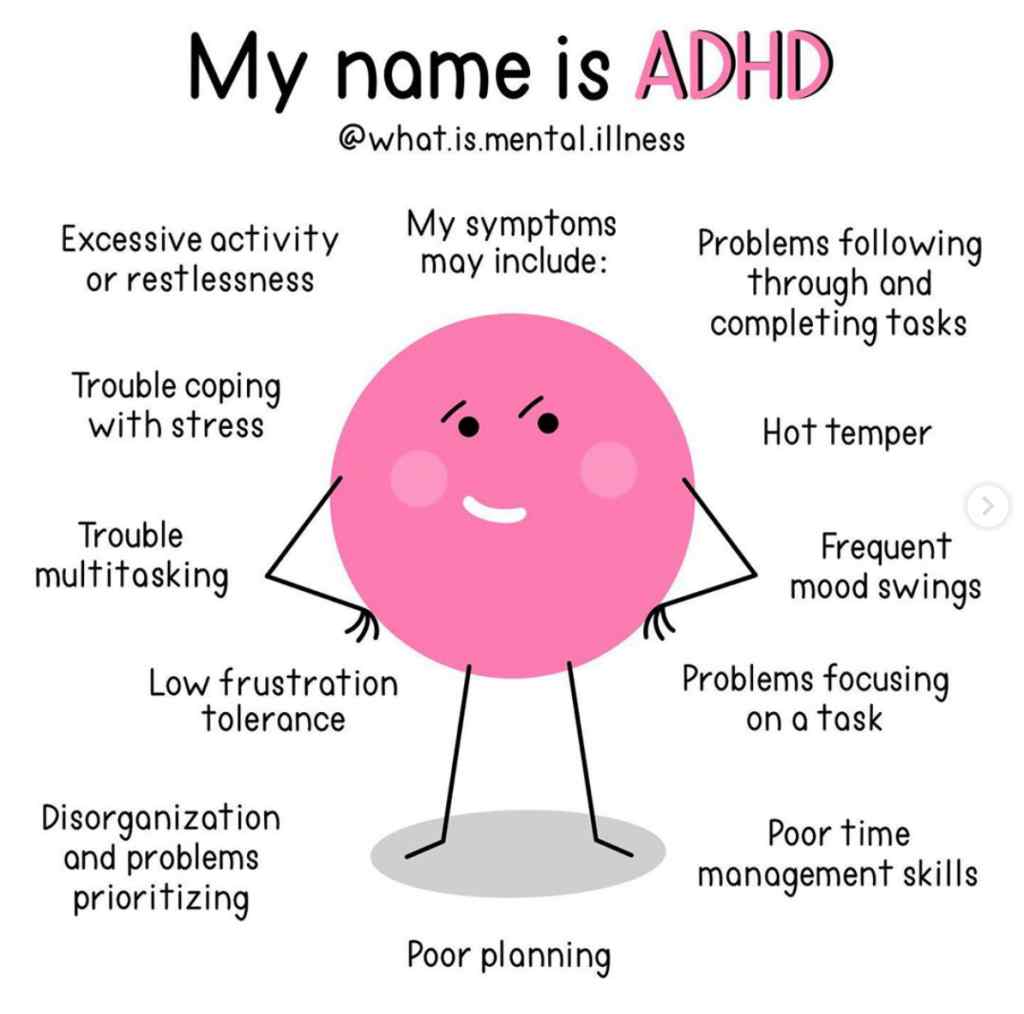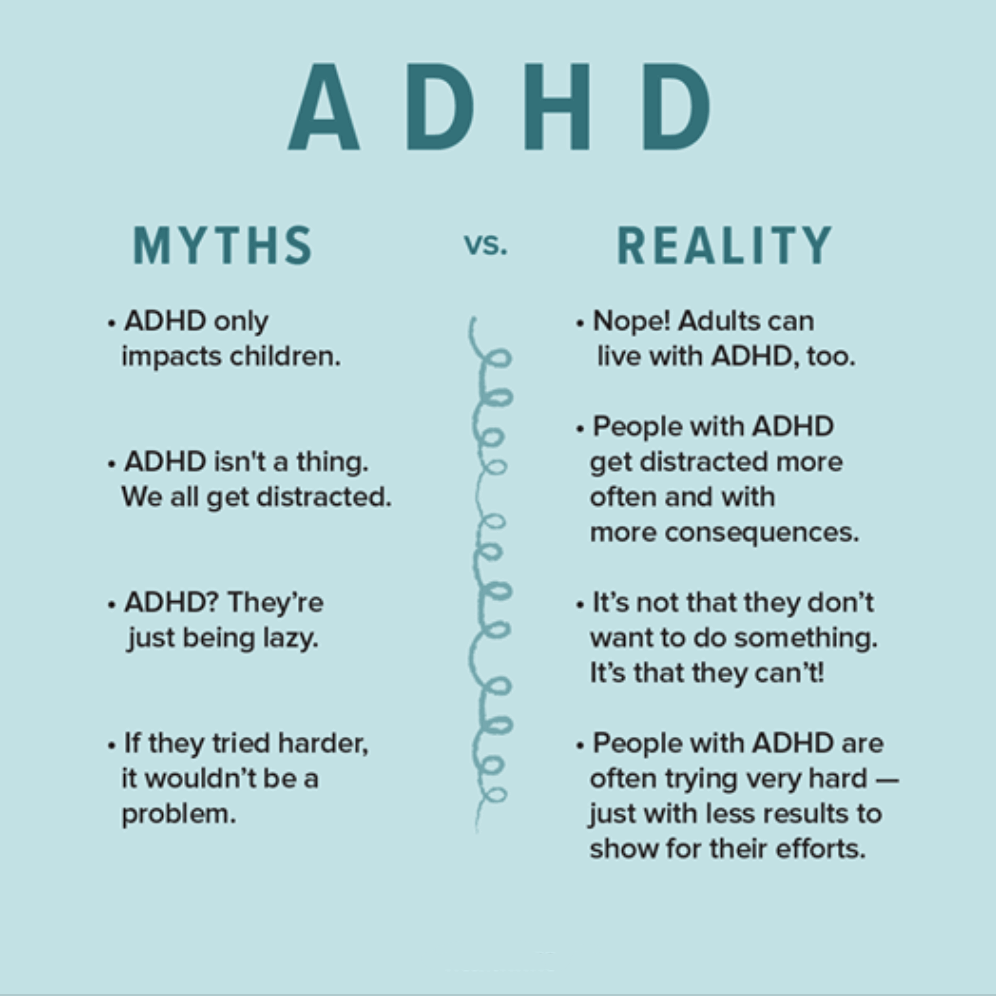Phillips-ADHD Introduction
Introduction to ADHD/What Is It?

https://literallyausome.com.au/cms/wp-content/uploads/2022/02/ADHD.1.jpg
Many people have probably heard of ADHD but may not fully understand what this entails. ADHD has a proper term which stands for "Attention Deficit Hyperactivity Disorder" and this is a condition that affects many people starting from children going into adulthood. There is the common stigma that an individual with ADHD is just very hyper and cannot stay still. When looking further into this disorder, there is much more that others may not be aware of. Looking into the overview of ADHD, the common stereotypes with this disability and other factors such as cultural perceptions can hopefully bring more light to people who are dealing with this disability and for others to be informed before making assumptions.
To get a general overview of what ADHD is, there is a more detailed definition for those who truly do not know what it means. Attention-deficit hyperactivity disorder (ADHD) is a complex, heterogeneous and multifactorial neurodevelopmental disorder characterized by persistent symptoms of inattention, hyperactivity and impulsivity (Martinez-Badía & Martinez-Raga, 2015). This typically can begin in childhood which can then lead to children having trouble paying attention, controlling impulsive behaviors, or being overly active.
Historical/Contemporary Overview
Looking into the historical views regarding what ADHD is defined as, the history goes back to the 19th century. An analysis of historical literature suggests that children presenting with symptoms of inattention, hyperactivity, and impulsivity have previously been described by several authors during the last 200 years (Lange et al., 2010). Moving along within history, there have been different terms associated with ADHD that people today may have a different view on. Along the 20th century, “minimal brain damage”, “minimal brain dysfunction”, “minimal brain disorder”, “hyperkinesis” or simply the “hyperactive child syndrome” are among the many different terms used to refer to what is currently known as ADHD (Martinez-Badía & Martinez-Raga, 2015).
The description throughout history can be seen as being similar to the contemporary view on ADHD in the modern era today as far as the symptoms are mentioned. Diving into the contemporary viewpoint of ADHD, there is a a more scientific viewpoint. The contemporary concept of attention deficit hyperactivity disorder (ADHD) as defined in the DSM-IV-TR (American Psychiatric Association 2000) is relatively new (Lange et al., 2010). Comparing the contemporary viewpoint of ADHD to the historical viewpoint, there seems to be more of a focus surrounding the symptoms of inattentiveness and hyperactivity to better help others differentiate the signs instead of placing someone in one "box".
ADHD Inattentive Symptoms
- Is easily distracted
- Has difficulty sustaining attention
- Fails to give close attention to detail
- Avoids/dislikes tasks requiring sustained mental effort
- Fidgets with hands or feet
- Difficulty waiting or taking turns
- Interrupts others
- Has difficulty remaining seated
Stereotypes & Stereotypical Thinking
When it comes to ADHD, it may be a common thought that this disorder refers to someone being overly hyperactive and not being able to stay still. This is just one of various stigmas that has been placed within when discussing or thinking about it. Thinking about a time when there wasn't much research about this disorder decades ago and looking at the modern day, there is the hope that the stereotypical thinking has decreased. Unfortunately, there is no such thing that is perfect and even though time has passed with more research and information being presented about ADHD, there are still people who will have different thoughts or opinions with this disorder. Just like any other disorder, there is always going to be some form of stigma in society that unfortunately people who are dealing with ADHD cannot escape. Surprisingly, in 2010 it was mentioned that during the last 10 years, the number of studies examining the impact of stigma, prejudice, and discriminating behavior on the mental health and life satisfaction of people at risk for, or already diagnosed with a mental disorder (Brohan et al. 2010) increased considerably (Mueller et al., 2012). Thinking back to the mention of children being diagnosed with this disorder, it is more than likely that school-aged children are being judged by other children in their class or throughout the school. This in turn can make them be excluded from being with different groups of children or being able participate in certain events due the stigmatized thoughts that constantly occur. Moreover, ADHD`s association with social norm violation and the society’s tendency to accuse affected individuals of being unwilling to fit into the social system makes the diagnosed person likely to face consequences of stigma (Mueller et al., 2012).
 |
| https://www.calmsage.com/wp-content/uploads/2020/08/myths-vs-facts-adhd.png |
Cultural Perceptions
Cultural perceptions on disorders can vary depending on the culture and the disorder itself. Some cultures may be open to acknowledging certain disorder diagnoses, while other cultures may view disorders as unacceptable or simply do not believe in them. The over cultural perception to disorders such as ADHD can impact the acceptance of the diagnosis and possibly the treatment process. Their reaction and response to a condition such as ADHD can thereby add new barriers to already existing patient engagement and diagnosis challenges (Goshal, 2022). Data show that cultural attitudes and sensitivities about ADHD can delay diagnosis, impact treatment rates, and affect use of stimulant medications. These beliefs differ around the globe among different racial and ethnic groups, including Asian, Middle Eastern, African, and those of South American descent (Goshal, 2022). Overall, this cultural perception is another layer that people may not take into account or are not fully aware of when speaking about ADHD or any other disorder which makes it more of a reason to bring more awareness. There possibly may be individuals out there dealing with ADHD from different cultural backgrounds that may need help with getting their families to be more accepting to their disorder.
References
Ghoshal, M. (2022, March 9). How race and culture can impact an ADHD diagnosis - psycom. PsyCom Pro. Retrieved September 7, 2022, from https://pro.psycom.net/assessment-diagnosis-adherence/adhd/adhd-and-culture-a-complex-dynamic-influences-diagnosis-and-treatment-in-bipoc-patients
Lange, K. W., Reichl, S., Lange, K. M., Tucha, L., & Tucha, O. (2010, December). The history of attention deficit hyperactivity disorder. Attention deficit and hyperactivity disorders. Retrieved September 6, 2022, from https://www.ncbi.nlm.nih.gov/pmc/articles/PMC3000907/
Martinez-Badía, J., & Martinez-Raga, J. (2015, December 22). Who says this is a modern disorder? the early history of attention deficit hyperactivity disorder. World journal of psychiatry. Retrieved September 6, 2022, from https://www.ncbi.nlm.nih.gov/pmc/articles/PMC4694551/
Mueller, A. K., Fuermaier, A. B. M. B. M., Koerts, J., & Tucha, L. (2012, September). Stigma in attention deficit hyperactivity disorder. Attention deficit and hyperactivity disorders. Retrieved September 6, 2022, from https://www.ncbi.nlm.nih.gov/pmc/articles/PMC3430836/
:max_bytes(150000):strip_icc()/adhd-attention-deficit-hyperactivity-disorder-included-definition-symptoms-traits-causes-treatment-5084784_final-bc92546bc9df465ea7f13fc423c2085b.jpg)
Comments
Post a Comment